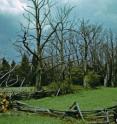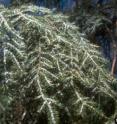UCSB study shows forest insects and diseases arrive in US via imported plants
Related images
(click to enlarge)
The trade in live plants from around the world has become a major industry in the United States, with new imports now valued at more than $500 billion annually. According to a study conducted by researchers at UC Santa Barbara's National Center for Ecological Analysis and Synthesis, however, what has proved to be a boon for the economy has also been shown to have devastating effects on the environment. The multidisciplinary working group found that almost 70 percent of the most damaging non-native forest insects and diseases currently afflicting U.S. forests arrived via imported live plants. The group's findings appear in the current issue of the journal Frontiers in Ecology and the Environment.
The study, led by Andrew Liebhold, a Forest Service researcher with the U.S. Department of Agriculture, shows that in the last 43 years, the quantity of plant imports to the U.S. has risen by more than 500 percent, peaking at 3.15 billion plants in 2007. Nearly half of the imported live plants entering the U.S. are destined for either California or Florida.
Once introduced, some of these imported insects and disease organisms become established, and a fraction of those become major economic pests. For example, Sudden Oak Death, which is caused by the plant pathogen Phytophthora ramorum, was introduced into the Bay Area and Big Sur regions of California via nursery plants. The disease has now spread through 14 counties in California, as well as southern Oregon, where it has caused large-scale die-off of tanoaks, live oaks, and black oaks.
The authors studied 82 high-impact invasive insects and diseases in detail. Of these, 95 percent of sap-feeding insects and 89 percent of foliage-feeding insects probably arrived on live plants. In contrast, roughly 85 percent of wood- and phloem-boring insects likely entered the country on wood packaging materials, logs, lumber, or other wood sources.
"The demand for live plants from outside the United States is not likely to diminish," said Liebhold. "As global trade expands, our knowledge of pest pathways must be improved to ensure trade is accomplished with minimal environmental degradation."
According to Liebhold, the working group's current research provides specific information that is critical to the development of policies to reduce the risk of pest species associated with the trade in live plants. Current policies are based on outdated assumptions about the size and number of shipments, and do not address the very large number of plants now grown abroad for direct resale in the U.S., he said.
The authors describe several possible means to increase bio-security, including intensified efforts at plant inspection stations; precautionary measures that restrict plants from entering the U.S. until they have been assessed as posing very little risk; expanding the post-entry quarantine currently applied mainly to some crop plants to include ornamental plants; developing better advance knowledge about pest insects and pathogens; and developing integrated systems approaches that depend on expanded partnerships between researchers and industry.
Source: University of California - Santa Barbara
Other sources
- Imported plants bring U.S. forest threatsfrom UPITue, 10 Apr 2012, 3:00:29 UTC
- Imported plants bring U.S. forest threatsfrom UPITue, 10 Apr 2012, 2:30:33 UTC
- Study shows forest insects and diseases arrive in US via imported plantsfrom PhysorgMon, 9 Apr 2012, 20:10:10 UTC
- Forest insects and diseases arrive in US via imported plantsfrom Science DailyMon, 9 Apr 2012, 18:29:50 UTC


